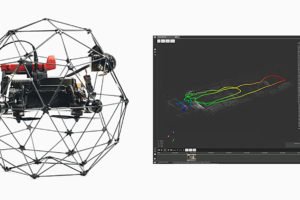
by DRONELIFE Staff Writer Ian M. Crosby
Flyability, a Switzerland based company with a focus on indoor drones for inspections in challenging environments, has launched the Elios 2 RAD, a drone equipped with a radiation sensor made for inspections at nuclear stations.
Traditionally, nuclear stations have relied on personnel to maintain low radiation exposure levels. The introduction of the Elios 2 RAD provides a significant increase in worker safety. Designed to help reduce radiation exposure wherever possible, the model is made to take the place of personnel in collecting visual and radiation data. It is also capable of providing high-quality data for planning interventions that do require exposure, in order to keep it to a minimum.
With its built in energy Geiger-Muller detector, the Elios 2 RAD can detect radiation while in flight through Flyability’s piloting app. Afterwards, engineers can use Flyability’s Inspector 3.0 software to map the radiation along the drone’ flight path, showing the exact location of dangerous dose levels. They can then play back the inspection flight within Inspector 3.0, using it to see dose rate measurements displayed on top of the video footage.
“The Elios 2 RAD represents the first chapter in our efforts to create indoor drones targeted specifically for each of our key verticals, accelerating our mission to use robots instead of people for dangerous indoor inspection jobs,” says Flyability’s CEO Patrick Thévoz. “The Elios 2 RAD has the potential to significantly reduce the need for inspectors to be exposed to harmful radiation or to the hazards of confined space entry for the purposes of conducting routine inspections.”
Prior to the launch of the Elios 2 RAD, Flyability has already had a strong presence at nuclear facilities around the world. Its predecessor, the Elios 2 model, has been tested successfully at up to 800 R/H, and nuclear inspectors have reported using it to save six figures in a single inspection flight by reducing downtimes and avoiding the need for scaffolding and other costly temporary structures. What’s more, inspectors state that these results are not unique, but are in fact repeatable and a regular part of the new workflows the Elios 2 enables.
“Over 80% of U.S. nuclear operators already use Flyability’s indoor drones for their visual inspections,” says Alexandre Meldem, VP of Sales. “Now we can expand that support by allowing engineers to collect actionable, high quality dose data. Helping nuclear inspectors collect this data remotely means that less people will be exposed to the potential harm of radiation.”
In 2020, Flyability released footage of a flight taken with its Elios drone at the Chernobyl disaster site, the goal of which was to collect visual data within the never activated Reactor 5 to confirm the absence of nuclear fuel bars. With the release of the Elios 2 RAD, it will now be possible to return and not only test for the presence of bars, but also record the amount of radiation present throughout the entire site.